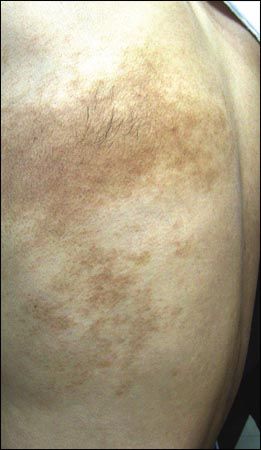- Clinical Technology
- Adult Immunization
- Hepatology
- Pediatric Immunization
- Screening
- Psychiatry
- Allergy
- Women's Health
- Cardiology
- Pediatrics
- Dermatology
- Endocrinology
- Pain Management
- Gastroenterology
- Infectious Disease
- Obesity Medicine
- Rheumatology
- Nephrology
- Neurology
- Pulmonology
Hairy Hyperpigmented Lesion on a Teenager’s Back
A 16-year-old boy with asymptomatic, hyperpigmented, hairy lesion on his left upper back. The pigmentation, first noted 5 years earlier, had progressively spread across his torso. The coarse and dark hair confined to the hyperpigmented area had appeared at age 13 years. Medical history uneventful. Review of systems showed no abnormalities. No family history of similar skin lesions.

HISTORY
A 16-year-old boy with asymptomatic, hyperpigmented, hairy lesion on his left upper back. The pigmentation, first noted 5 years earlier, had progressively spread across his torso. The coarse and dark hair confined to the hyperpigmented area had appeared at age 13 years. Medical history uneventful. Review of systems showed no abnormalities. No family history of similar skin lesions.
PHYSICAL EXAMINATION
Large, segmental, well-demarcated, irregularly margined, brownish patch with hypertrichosis on the left lateral, upper back. Remaining physical findings unremarkable.
“WHAT'S YOUR DIAGNOSIS?”
ANSWER:BECKER NEVUS
An acquired, sharply demarcated, brownish patch with geographical borders and overhanging hypertrichosis is characteristic of a Becker nevus. This disorder is named after Samuel William Becker, who in 1949 reported 2 cases of a hyperpigmented and hypertrichotic lesion with unilateral distribution.1
PREVALENCE AND ETIOLOGY
A Becker nevus occurs in about 0.5% of adolescent boys and young men.2 The male to female ratio is approximately 5:1.2 The exact pathogenesis is not known; however, a target tissue increase in androgen receptors or sensitivity to androgens may be responsible.3
HISTOPATHOLOGY
Histopathological features include regular elongation of rete ridges, hyperpigmentation of the basal layer, acanthosis, and hyperkeratosis.2 Although the lesion is called a nevus, nevus cells are absent in the dermis. Thus, malignant transformation is not a concern.
CLINICAL MANIFESTATIONS
A Becker nevus typically begins in the second decade of life as a circumscribed brownish macule or patch that gradually enlarges in an irregular fashion, similar to a geographical configuration. Hypertrichosis usually develops a few years after the pigmentation. The hairs generally appear in the region of the pigmentation but are not necessarily confined to that area; they become coarser and darker with time. The lesion is typically asymptomatic and unilateral, with a predilection for the shoulder and upper chest.2
Although Becker nevus is usually an acquired disorder, congenital and familial cases have been described. Occasionally, it may be associated with ipsilateral breast hypoplasia, smooth muscle hamartoma, lipoatrophy, and musculoskeletal anomalies (including ipsilateral aplasia of pectoralis major, ipsilateral limb shortening, scoliosis, hemivertebrae, and spina bifida occulta).4 The term "Becker nevus syndrome" has been used to describe the association of a Becker nevus with noncutaneous anomalies.
DIFFERENTIAL DIAGNOSIS
The Table lists the differential diagnosis of Becker nevus. Of the conditions included, congenital melanocytic nevus, café au lait patch, and Albright syndrome are present at birth or appear shortly thereafter. Nevus spilus generally develops within the first year of life.
TREATMENT
Except for cosmesis, no treatment is necessary. The hyperpigmentation can be treated with Q-switched lasers. The hypertrichosis can be treated with depilation.
References:
REFERENCES:1. Becker SW. Concurrent melanosis and hypertrichosis in distribution of nevus unius lateris. Arch Derm Syphilol. 1949;60:155-160.
2. Hsu S, Chen JY, Subrt P. Becker's melanosis in a woman. J Am Acad Dermatol. 2001;45(suppl 6):S195-S196.
3. Ro YS, Ko JY. Linear congenital Becker nevus. Cutis. 2005;75:122-124.
4. Danarti R, König A, Salhi A, et al. Becker's nevus syndrome revisited. J Am Acad Dermatol. 2004;51:965-969.
Kymera's Oral STAT6 Degrader KT-621 Shows Biologic-Like Activity in Early Atopic Dermatitis Trial
December 8th 2025KT-621 achieved deep STAT6 degradation and strong 4-week EASI and itch reductions, offering a potential new oral option for moderate–severe AD and other Th2 inflammation-driven disease.
